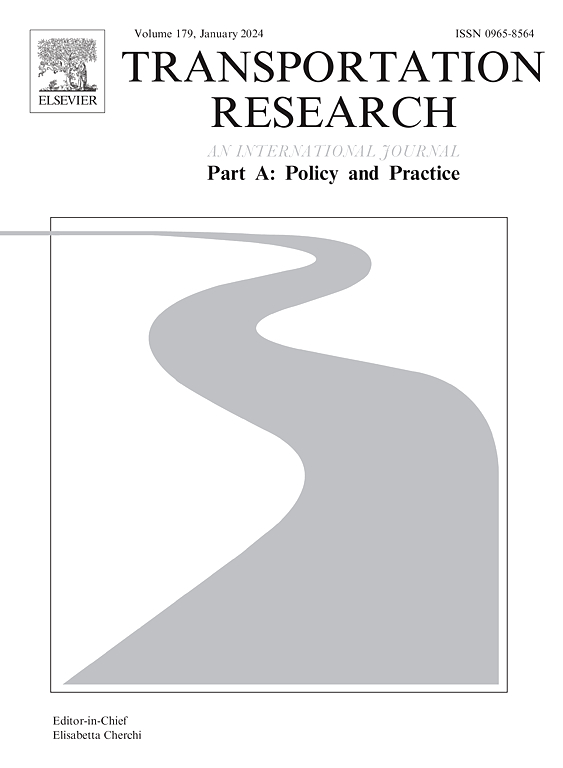Willingness to limit “panic buying” during the COVID-19 crisis
IF 6.3
1区 工程技术
Q1 ECONOMICS
Transportation Research Part A-Policy and Practice
Pub Date : 2024-11-18
DOI:10.1016/j.tra.2024.104317
引用次数: 0
Abstract
The research in this paper seeks to quantify the potential of a novel initiative to mitigate “panic buying” through appeals from “trusted change agents” (TCAs) that ask individuals to limit their purchases of critical supplies. TCAs are agents involved in disaster response efforts, such as local leaders and representatives of relief groups, that are deemed to be trustworthy by various segments of the population. To assess the effectiveness of these appeals, the authors conducted a survey of residents in the United States (U.S.) to characterize the respondents’ purchases of critical supplies made before, during, and after the pandemic. In addition, stated preference data were gathered about whether, and the extent to which, the respondents would react to a request from TCAs to limit their purchases of critical supplies. The results of the survey were used to: (i) assess the level of trust the respondents have in the various agents considered; (ii) estimate the expected impacts of TCAs’ requests in terms of changes in respondents’ purchasing behaviors; and (iii) estimate a Structural Equation Model-Multiple Indicators Multiple Causes (SEM-MIMIC) model that expresses the respondents’ willingness to limit purchases as a function of the socioeconomic attributes of the respondents. The research demonstrated that TCAs have substantial influence, with 58 % of respondents willing to limit purchases based on TCAs’ appeals. Firefighters, Emergency Responders, and Health Officials are the most trusted agents, with Firefighters having the highest expected impact (22.2 %). Joint appeals amplify impact, e.g., Firefighters combined with Local Government and Emergency Responders have an impact of 33.3 %. The SEM-MIMIC model also showed that socioeconomic variables affect trust in TCAs. The results of the research provide a pathway to mitigate “panic buying” and reduce the associated shortages. Based on the results obtained, the authors discuss the corresponding policy implications.
在 COVID-19 危机期间限制 "恐慌性购买 "的意愿
本文的研究旨在量化一项新举措的潜力,通过 "可信赖的变革推动者"(TCAs)的呼吁,要求个人限制购买关键物资,从而缓解 "恐慌性购买"。TCAs 是指参与救灾工作的人员,如地方领导人和救援团体代表,他们被不同人群认为是值得信赖的。为了评估这些呼吁的有效性,作者对美国居民进行了一项调查,以了解受访者在大流行之前、期间和之后购买重要物资的情况。此外,还收集了关于受访者是否会对 TCA 提出的限制购买重要物资的要求做出反应以及反应程度的陈述偏好数据。调查结果用于(i) 评估受访者对各代理机构的信任程度;(ii) 从受访者购买行为的变化角度估算三方协议要求的预期影响;(iii) 估算结构方程模型--多指标多原因(SEM-MIMIC)模型,该模型将受访者的限购意愿作为受访者社会经济属性的函数来表达。研究表明,TCA 具有很大的影响力,58% 的受访者愿意根据 TCA 的呼吁限制购买。消防员、应急人员和卫生官员是最值得信赖的代理人,其中消防员的预期影响力最高(22.2%)。联合呼吁可扩大影响,例如,消防员与地方政府和应急人员联合呼吁的影响为 33.3%。SEM-MIMIC 模型还显示,社会经济变量会影响对 TCA 的信任。研究结果为缓解 "恐慌性购买 "和减少相关短缺提供了一条途径。根据所获得的结果,作者讨论了相应的政策影响。
本文章由计算机程序翻译,如有差异,请以英文原文为准。
求助全文
约1分钟内获得全文
求助全文
来源期刊
CiteScore
13.20
自引率
7.80%
发文量
257
审稿时长
9.8 months
期刊介绍:
Transportation Research: Part A contains papers of general interest in all passenger and freight transportation modes: policy analysis, formulation and evaluation; planning; interaction with the political, socioeconomic and physical environment; design, management and evaluation of transportation systems. Topics are approached from any discipline or perspective: economics, engineering, sociology, psychology, etc. Case studies, survey and expository papers are included, as are articles which contribute to unification of the field, or to an understanding of the comparative aspects of different systems. Papers which assess the scope for technological innovation within a social or political framework are also published. The journal is international, and places equal emphasis on the problems of industrialized and non-industrialized regions.
Part A''s aims and scope are complementary to Transportation Research Part B: Methodological, Part C: Emerging Technologies and Part D: Transport and Environment. Part E: Logistics and Transportation Review. Part F: Traffic Psychology and Behaviour. The complete set forms the most cohesive and comprehensive reference of current research in transportation science.

 求助内容:
求助内容: 应助结果提醒方式:
应助结果提醒方式:


